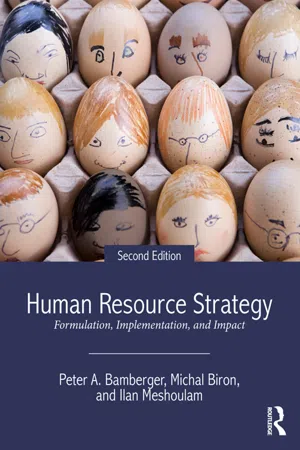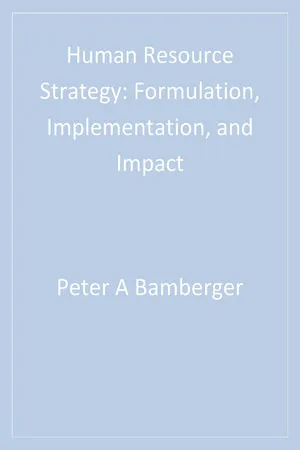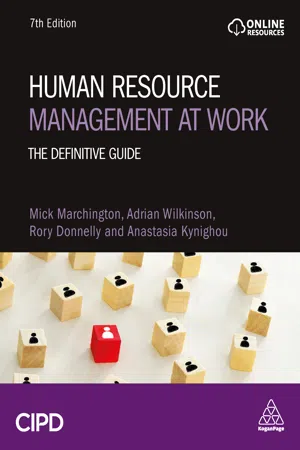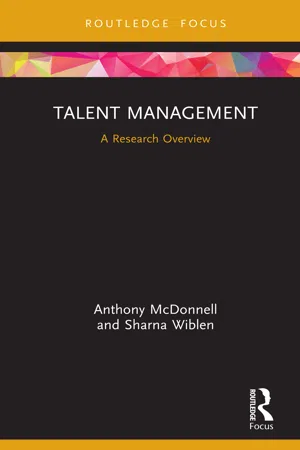Business
Human Resource Flow
Human resource flow refers to the movement of employees into, within, and out of an organization. It encompasses processes such as recruitment, onboarding, training, career development, and offboarding. Managing human resource flow effectively is crucial for ensuring the right talent is in the right place at the right time, and for maintaining a skilled and motivated workforce.
Written by Perlego with AI-assistance
Related key terms
4 Key excerpts on "Human Resource Flow"
- Available until 20 Sep |Learn more
Human Resource Strategy
Formulation, Implementation, and Impact
- Michal Biron, Corine Boon, Peter A. Bamberger(Authors)
- 2014(Publication Date)
- Routledge(Publisher)
Rao, 2009 ). As such, the people flow subsystem has a direct impact on a firm’s human capital and, thus, its ability to meet its objectives in terms of composition (e.g., running fat or lean), competence (e.g., stock of knowledge, skills, and abilities), and cost.The strategic implications of the practices involved in the people flow subsystem may not be obvious at first glance. Indeed, many of these practices, such as recruitment and development, may appear quite technical in nature. This may explain why the people flow subsystem has traditionally received much less attention than, say, the strategic implications of the compensation subsystem. However, practices like recruitment, development, and termination can only be put into effect once a number of very basic decisions are made—decisions that can have a profound, long-term, and hence strategic impact on any organization. These decisions concern, for example, the degree to which the firm is willing to be dependent on the external labor market (ELM) to supply it with its required human capital, the steps the firm is willing to take to protect its investments in human capital, and the extent to which the organization is willing to select candidates on the basis of long-term potential as opposed to proven achievements in the past. - eBook - ePub
Human Resource Strategy
Formulation, Implementation, and Impact
- Peter A. Bamberger, Ilan Meshoulam(Authors)
- 2000(Publication Date)
- SAGE Publications, Inc(Publisher)
Dyer and Holder (1988) defined staffing as the set of practices designed to shape the characteristics of the organizational workforce: that is, the process of matching people with jobs. In this sense, the people flow or staffing subsystem encompasses those practices and processes that have a direct impact on the ability of the firm to meet its composition (e.g., running fat or lean), competence (e.g., stock of knowledge, skills, and abilities), and cost objectives. Others adopt an even broader definition of the staffing system. For example, Beer et al. (1985) described staffing as a process that governs “the flow of people into, through and out of the organization” (p. 9). As such, it encompasses a whole arena of interrelated organizational activities such as human resource planning, job analysis, recruitment, selection, entry and placement, mobility, evaluation, career planning and development, and termination. Similarly, Dreher and Kendall (1995) viewed the staffing system as encompassing all of the means by which the organization attempts to shape the composition of its workforce, including such functions as recruitment, screening, selection, promotion, and retention/separation management.Most of these functions may sound quite technical, and it may be difficult, at least at first glance, to see how this HR subsystem might have strategic implications. Indeed, researchers have paid relatively little attention to the strategic implications of the people flow subsystem compared to the amount of attention paid to the strategic implications of organizational reward subsystems. However, when one thinks about it, such staffing and development practices can be put into effect only when a number of very basic decisions are made—decisions that can have profound, long-term, and hence strategic impact on any organization. These decisions concern, for example, the degree to which the firm is willing to be dependent on the external labor market (ELM) to supply it with its required human capital, the steps the firm is willing to take to protect its investments in human capital, and the extent to which the organization is willing to select candidates on the basis of some indication of “long-term potential” as opposed to proven achievements in the past. - eBook - ePub
Human Resource Management at Work
The Definitive Guide
- Mick Marchington, Adrian Wilkinson, Rory Donnelly, Anastasia Kynighou(Authors)
- 2020(Publication Date)
- CIPD - Kogan Page(Publisher)
Resourcing and Talent Planning (CIPD, 2017b) survey indicate that the median spend on advertising, agency or search fees for a senior manager/director was £6,000 – a cost that can escalate if a poor selection decision is made. This chapter reviews resourcing and talent management, paying particular attention to recruitment and selection, from workforce planning through to appointment. Care is needed at each stage to ensure the organisation continues to convey the message it wants to maintain its reputation in the marketplace; corporate advertising, in general and for recruits in particular, has an impact upon applications (Auger et al, 2013).7.2 Workforce planning, turnover and retention
At a time when world markets were more stable and predictable, workforce planning was a prominent feature of organisational HRM. There was an extensive literature on the topic and leading organisations planned future employment needs, especially of managers, in a systematic way. This was referred to as the ‘golden age of manpower planning’, and the techniques in favour at the time drew heavily upon statistical techniques. While some HRM texts still include a chapter on workforce planning (for example, Torrington et al, 2017; Taylor, 2018), the majority (for example, Boxall and Purcell, 2016; Beardwell and Thompson, 2017) no longer bother. In the context of ‘flexible and agile’ ambidextrous organisations that draw on existing capabilities while simultaneously exploring new ones (Junni et al, 2015), workforce planning conveys images of bureaucracy, rigidity and a failure to comprehend the limitations of planning in a turbulent and uncertain political and economic environment. One of the problems with workforce forecasting is that it draws on past organisational experiences, which may not be repeated, to predict the future. This limitation can be used to justify ad hoc solutions and lead to short-termism.However, as Taylor (2018) and Picardi (2020) remind us, planning remains critically important during turbulent times, if only to ensure that employers have staff of the right quality and quantity available when needed. The decision by many firms not to lay off key staff during a recession or during the Brexit uncertainties from 2016 to 2020 but to retain them on reduced hours or allow sabbaticals shows concerns about having to re-recruit at a future time when demand may outstrip the supply of suitable labour. Moreover, pressures to control labour costs and protect profit margins at the same time as engaging a workforce in a more agile and scalable way could imply an increased emphasis on workforce planning by employers, both in terms of their own employees and those employed by subcontractors down the supply chain (Marchington and Kynighou, 2012). - eBook - ePub
Talent Management
A Research Overview
- Anthony McDonnell, Sharna Wiblen(Authors)
- 2020(Publication Date)
- Routledge(Publisher)
The second perspective focuses on resource allocation and attention to the creation of talent pools. This perspective views all employees as valuable resources regardless of the specific needs or strategic aims of an organisation; focuses on establishing a set of processes designed to ensure an adequate flow of employees into jobs throughout the organisation (Lewis & Heckman, 2006). As such it draws heavily on succession planning and manpower planning (Mellahi & Collings, 2010) and is driven by the desire to manage talent pools in relation to specific, mainly senior management and leadership positions (Thunnissen et al., 2013). This perspective would however appear to be a more dynamic approach to succession planning where the focus is on greater consideration of the future value of human capital to various positions, though these roles may not be explicitly mapped out (Lepak, Takeuchi & Swart, 2011). This perspective suggests a more dynamic approach is needed where an organisation has multiple (pools) of people who possess vital base abilities, competencies and knowledge that could with appropriate support and training and development move into one of several roles. This perspective has seen calls for HR to give greater consideration to the use of scenario planning and supply chain management (Cappelli, 2008; Schuler, Jackson & Tarique, 2011). A key criticism here is that it neglects that organisations may possess key talent pools by virtue of particular skills or knowledge they possess that stand outside managerial roles (McDonnell, Gunnigle, Lavelle & Lamare, 2016).Talent management as – the management of designated individuals
The third stream focuses on the management of talented people (Mellahi & Collings, 2010) without regard for specific positions or organisational boundaries. Lewis and Heckman (2006) propose two views of talent within this approach. The first positions talent concerning high-performing and high-potential employees, where a workforce is divided and managed according to these relative levels. Talent management ordinarily commences with identifying and mobilising internal talent pools (Boudreau & Ramstad, 2005; Bryan, Joyce & Weiss, 2006). Differentiation, according to performance-based criteria and evaluations, enables organisations to fill all roles and positions with ‘A Performers’. Organisations also manage lower performers, known as ‘C Performers’, out of the organisation (Collings & Mellahi, 2009; Michaels, Handfield-Jones & Axelrod, 2001). This approach has seen much discussion and many comments with links to forced distribution or top grading systems as popularised by Jack Welch at GE. The focus is firmly on attracting, retaining and appropriately rewarding the top performers regardless of role (Lewis & Heckman, 2006).
Index pages curate the most relevant extracts from our library of academic textbooks. They’ve been created using an in-house natural language model (NLM), each adding context and meaning to key research topics.



